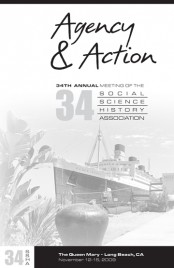Vortrag in Long Beach, November 2009

Unter dem Titel „Migrant Accommodation around 1900: Vienna vs. ‚North America‘ “ hat Wladimir Fischer am 34. Social Science History Association Meeting in Long Beach, Kalifornien, einen ersten Entwurf präsentiert, wie man von Forschungsergebnissen zu MigrantInnen in Wien um 1900 eine Brücke zu MigrantInnen in den USA aus Österreich-Ungarn schlagen kann. Die Sektion mit dem Namen „The Trans-National Immigration Experience from the Austro-Hungarian Empire, 1870-1914“ war von Annemarie Steidl (Universität Wien, Inst. f. Wirtschafts- und Sozialgeschichte) organisiert worden. Steidl und James Oberley (University of Wisconsin, Eau Claire) präsentierten papers zu den Themen Understanding the Transatlantic Migration Experience: Divers and Similar Migration Patterns of Various Social, Cultural, Religious, and Ethnic Groups from the Austro-Hungarian Monarchy und Marriage Across National Boundaries: From the Austro-Hungarian Monarchy to the East Side of New York, 1849-1940.
Die Diskussion mit der Respondentin Jan Reiff (University of California, Los Angeles) war äußerst lebhaft und streifte unter anderem die Frage, ob Öffentlichkeit in den USA mit Öffentlichkeit in Mitteleuropa überhaupt vergleichbar ist. Den Vorsitz führte Tobias Brinkmann (Pennsylvania State University).
Abstracts:
J. Oberly. “Marriage Across National Boundaries: From the Austro-Hungarian Monarchy to the East Side of New York, 1849-1940”.
This study examines age-of-marriage patterns from a set of villages and towns from a region in present-day Slovakia that was once part of the Austro-Hungarian Monarchy’s territory, and then traces the married couples who emigrated to New York over the next generation. The study makes use of the marriage register of Eperjes/Presov from 1849 in the then-Kingdom of Hungary and IPUMS-USA for the changes in marriage patterns among immigrants from the region who relocated to New York. The study also makes use of Hungarian-language and English-language primary source letters, newspaper articles, and reports.
W. Fischer. Migrant Accommodation around 1900: Vienna vs. ›North America‹.
Building upon findings on migrants from the South-eastern provinces of the Habsburg Monarchy in fin-de-siècle Vienna, my paper will give an outlook on research on migrants in North America from the same region in the same period. The method of description relies on describing small compartments of migrant networks (familial, professional, economic, institutional) and of strategies of cultural-political self-representation and community organization. This micro-approach allows for highlighting the interaction of migrants with various and interlacing socio-cultural systems from labor and living to community and politics. There will be an emphasis on presumptive contrasts between accommodation in Vienna and the cities migrants chose in North America, such as the pioneer role of the Slovenes in America vs. their problem to maintain their profile in Catholic Vienna, or the obviously different relations between ›sending‹ regions, social outlook of migrants, and travel distances in both cases.
A. Steidl. Understanding the Transatlantic Migration Experience: Divers and Similar Migration Patterns of Various Social, Cultural, Religious, and Ethnic Groups from the Austro-Hungarian Monarchy.
Social scientists and historians have developed a rich body of research on transatlantic migration during the nineteenth and twentieth centuries, but most studies have addressed migration as a phenomenon affecting either individual nation states or individual ethnicities. My paper will address the differences and similarities of multiple ethnic and socio-cultural groups which migrated from the Austro-Hungarian Monarchy to the US from 1870 to 1914. To overcome the limitations of an ethnic centered historiography and its self-referential evaluations, the comparative approach has served a valuable purpose. The extensive territory of the multi-ethnic Habsburg Monarchy will serve as an excellent case study for such a quantitative analysis, which will be based on census material from both parts of the Monarchy and the United States, as well as on ship passenger manifests from Ellis Island. The paper is part of a bigger research project, which will be conducted at the Center for Austrian Studies, at the University of Minnesota in Minneapolis. The project will use census material from the Minnesota Population Center, as well as more qualitative documents from the Immigration History Research Center. Therefore, my paper will also give insight into the future research of that project.